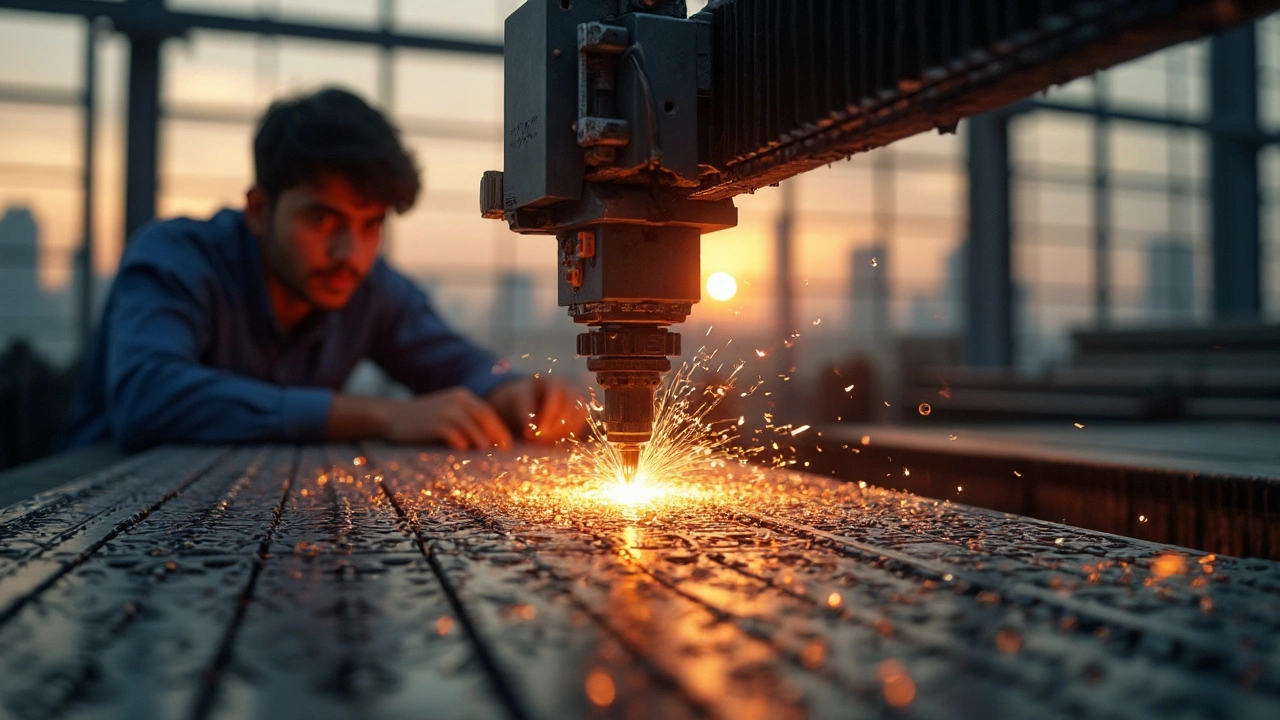If you think speed in machinery just means cranking out parts a little faster, you’re in for a surprise. India’s machine manufacturers are clocking speeds that would’ve sounded impossible a decade ago. We’re talking about textile machines rattling off over 2,000 meters of fabric a minute, CNC machines that can slice through metal faster than the eye can follow, and packaging units that spit out finished boxes almost as quickly as you can blink.
But why does all this matter? Quicker machines mean more output, less downtime, and bigger profits. If you’re running a factory, you know every minute saved can end up saving lakhs at the end of the year. The speed race in India isn’t just about bragging rights, either—it's changing the way factories operate and even challenging what used to be possible in manufacturing.
You’ll never look at an assembly line the same way after digging into who’s building these speedsters and how companies are using them to leap ahead of the competition. It’s not just global brands; plenty of Indian firms are making their mark on the world stage by rolling out machines that set new records for speed and efficiency.
- What Counts as 'Fast' in Machinery
- The Record-Breakers: Fastest Machines Made in India
- Who Builds These Speed Demons
- How Speed Impacts Business
- Buying Tips: Picking the Fastest for Your Factory
- Future of High-Speed Machines in India
What Counts as 'Fast' in Machinery
Speed means something different depending on the machine you’re talking about. For some, it’s all about how many units you can crank out in an hour. For others, it’s about meters per minute, cycles per second, or even how quickly you can retool and move to the next job. When you hear about the fastest machine in India, you have to ask—fast in what way?
If you check out the manufacturing floor in Indian factories, here’s how speed usually measures up:
- Production rate (units/hour or meters/minute): Textile weaving machines, for example, can run at over 2,000 meters per minute. Food packaging lines measure speed in boxes or packets per minute—some churn out 400–500 per minute.
- Cycle time: For machines like injection molders or stamping presses, it's about how fast they complete a cycle. Modern Indian presses can do 150–200 cycles per minute, which is top tier.
- Spindle speed (rpm): CNC and milling machines talk in rotations per minute. India's high-speed CNCs can hit up to 24,000 rpm with the right setup.
- Changeover time: Even if a machine is quick, downtime kills speed. So new machines focus on slashing the time to switch between jobs—some get changeover down to under 10 minutes.
To wrap your head around how fast things are actually moving, check out this quick table with real numbers from Indian manufacturers:
| Machine Type | Top Speed Achieved (India) | What It Means |
|---|---|---|
| Textile Weaving Loom | 2,200 m/min | High-volume fabric output |
| CNC Milling Machine | 24,000 rpm | Precision and fast metal cutting |
| Packaging Machine | 520 packs/min | Mass box/bag filling |
| Stamping Press | 200 cycles/min | Quick metal part shaping |
The numbers get even crazier in mass production zones—one bottling plant in Gujarat fills over 120,000 bottles an hour! If you’re eyeing speed, nail down the metric that matters in your industry before choosing a machine.
The Record-Breakers: Fastest Machines Made in India
When it comes to speed, India’s machine makers are killing it in more than one sector. Take the Lakshmi Machine Works (LMW) spinning frames—they churn out over 2,100 meters of yarn per minute. These machines aren’t just fast; they’re reliable enough to run shifts all week with barely a hiccup. LMW isn’t alone, though. In the packaging space, Nichrome’s high-speed automatic pouch packing machines roll out up to 240 packs per minute—think of the number of biscuit or snack pouches lining store shelves, day in and day out.
And you can’t forget the world of CNC (Computer Numeric Control) machines. ACE Micromatic’s vertical machining centers reach spindle speeds up to 24,000 RPM, letting factories finish complicated metal parts much faster than old-school lathes. This isn’t just about showing off; companies are getting major boosts in productivity with every machine upgrade.
“Speed is no longer just a feature; it’s the deciding factor for many manufacturers looking to compete worldwide,” says Ravi Raghavan, Editor of Manufacturing Today India.
Just for a better look, here’s how some of the fastest machine in India contenders compare:
| Machine | Manufacturer | Type | Peak Speed | Main Use |
|---|---|---|---|---|
| Ring Spinning Frame | Lakshmi Machine Works | Textile | 2,100 meters/min | Yarn Production |
| High-Speed Pouch Packing | Nichrome India | Packing | 240 packs/min | Food Packaging |
| CNC Machining Center | ACE Micromatic | Metal Machining | 24,000 RPM | Automotive Parts |
| Laser Cutting Machine | SLTL Group | Laser Cutting | 120 m/min traverse speed | Sheet Metal Fabrication |
Here are a few quick tips if you’re chasing top speed in your own setup:
- Check for service support—high-speed machines need quick fixes when things go wrong.
- Look at energy consumption. The fastest machine won’t help if your electricity bills go through the roof.
- Ask for real-world output data, not just the max speed on paper.
It's not all about the past, either. Many Indian brands are dropping new models every year that push the speed even further. So, keep an eye out—someone’s always ready to break the next record.
Who Builds These Speed Demons
India’s machinery scene is packed with brands that don’t just talk big—they deliver record speeds on the shop floor. If you’re asking who’s behind the fastest machines in India, some names stand out for good reason.
Lakshmi Machine Works (LMW) in Coimbatore turns heads globally for its textile spinning machines. Their ring frame models zip through over 2,000 meters of yarn per minute. In the packaging world, Uflex has built high-speed pouch-making lines that can knock out more than 300 pouches a minute. Want to talk about CNCs? Ace Micromatic packs serious punch with its CNC turning centers, which can process parts two to three times faster than many standard imports.
Suzlon, the wind turbine giant, keeps pushing the limits for big hardware, making some of the world’s fastest-turning turbine rotors right from its Pune facility. For smaller but speedy kit, Milacron India’s injection molding machines are everywhere—they turn around plastic products faster than most rivals in Southeast Asia.
Here’s a quick snapshot of key Indian manufacturers and their flagship speed machines:
| Manufacturer | Segment | Flagship Fast Machine | Top Speed/Throughput |
|---|---|---|---|
| Lakshmi Machine Works | Textile | Ring Frame Spinning Machine | 2,000+ meters/min |
| Uflex | Packaging | HSPML Pouch Machines | 300+ pouches/min |
| Ace Micromatic | Metalworking (CNC) | Sprint Series | Up to 5,000 RPM |
| Milacron India | Plastics | Quantum Series Injection Molding | 15-second cycle time |
| Suzlon | Energy/Wind Turbines | S144 Wind Turbine | 26 RPM (for large blades) |
What sets these players apart isn’t just raw speed. They back it up with local service teams, easy-to-find spare parts, and R&D that listens to actual factory needs. For anyone scouting for fastest machine in India options, checking out these names first can save a ton of research and headaches.
One handy tip—don’t just look at nameplates. Visit their demo centers or ask for a live run. It’s the best way to see speed and reliability in action before placing that big order.

How Speed Impacts Business
If you run a production floor, you already know every second matters. The fastest machine in India isn’t just a badge of honor—it can totally flip your balance sheet. Speed in machinery can mean the difference between lagging behind and leading your industry.
Let’s break down how speed shakes up the business side:
- Higher Output: Get more products off the line in less time. For example, India’s latest high-speed PET bottle blow-molding machines churn out up to 2,500 bottles per hour—triple what basic models did just five years ago.
- Saves on Labor: The faster your machine, the less human intervention you need to hit your targets, which means lower wage costs per unit produced.
- Faster Turnaround for Orders: Meeting those last-minute bulk orders from clients? Way easier. Textile spinning machines like the LMW SX8 run at over 25,000 RPM, helping mills deliver huge quantities right on time.
- Better Use of Resources: High-speed machines waste less energy per part produced, boosting your margins and shrinking your power bill.
- Staying Ahead of the Game: Got a fast new machine? You might snag big contracts before your competitors even have a chance to quote.
Here’s a snapshot of what faster machines can actually bring to your shop floor, with real numbers from leading Indian sectors:
| Industry | Standard Output | High-Speed Output (2024 data) | % Increase |
|---|---|---|---|
| Textile (spinning) | 15,000 spindles/hour | 25,000 spindles/hour | +66% |
| Packaging (bottles) | 1,000 bottles/hour | 2,500 bottles/hour | +150% |
| CNC Machining | 6 parts/min | 14 parts/min | +133% |
Till recently, going after high speed often meant compromising on accuracy or burning through machines with constant tears and repairs. Not anymore. Now, speed usually comes with solid reliability—provided you maintain those machines right and train your operators to keep up.
Ravi Mehra, CEO of FlexPack Industries, summed it up pretty well last year:
“Investing in high-speed machines changed our entire business. We deliver faster, our costs are down, and our customers notice the difference. We’re not just running faster—we’re outpacing the competition.”
If you’re on the fence about speeding things up, think about this: every day your line runs slower than it could, you’re handing profits to somebody else. Sometimes, it’s really that simple.
Buying Tips: Picking the Fastest for Your Factory
So, you’ve decided you want India’s fastest gear in your plant. Where do you even start? There’s more to this than grabbing the top speed number off a brochure. It’s easy to get swept up by speed specs, but trust me, you want the right mix of power, price, reliability, and after-sales support.
First, list out what you actually need. Are you in textiles? Then the Saurer Autocoro 10 rotor spinning machine is the king, handling up to 600 rotors at once and hitting a breakneck 200,000 rotors per hour. Or maybe you’re thinking metal and want a CNC. Jyoti CNC’s Millturns offer tool changes in under a second—no exaggeration—while maintaining serious precision for automotive or aerospace jobs. Packing boxes? Nichrome’s high-speed vertical form-fill-seal machines can punch out 150 packs per minute for snacks and powders. Fastest machine in India depends a lot on what industry you’re talking about.
When you’re ready to shop, compare not just speed but these details:
- Uptime & Service: Even the fastest machine is worthless if it’s always being fixed. Look for brands that actually deliver on maintenance promises. Some companies like Bharat Fritz Werner or Ace Micromatic have 24-hour support teams and keep spare parts in big cities for emergencies.
- Energy Use: Speed is pointless if your electricity costs double. For example, modern spinning and packaging machines offer up to 35% energy savings compared to models from 2015.
- Automation & Controls: Latest models have built-in sensors and touchpanels. You want easy troubleshooting and self-diagnostics, not clunky buttons from the 90s.
- Warranty & Upgrades: Ask about upgrade paths. Some Indian firms offer easy retrofits instead of forcing you into a whole new machine in a few years.
- User Reviews: Call a couple of other plant managers. If a company really walks the talk, folks in your industry will be open about their experience.
Here’s a quick comparison of popular high-speed machine brands and key stats:
| Brand/Model | Industry | Peak Speed | Typical Energy Savings | Support Network |
|---|---|---|---|---|
| Saurer Autocoro 10 | Textile | 200,000 rotors/hr | 30% | Pan-India |
| Jyoti CNC Millturns | Metalworking | Tool change <1 sec | 25% | 16 cities |
| Nichrome VFFS | Packaging | 150 packs/min | 35% | 12 cities |
Always run a trial if you can. Top manufacturers will gladly set up a demo at your site. It’s the best way to see if that machine’s headline speed works with your crew and your workflow day in, day out. Don’t just chase numbers—chase results that’ll stick for years.
Future of High-Speed Machines in India
The way things are shaping up, the future for fastest machine in India is only going to get more intense. Reports from IMTMA’s 2024 machinery expo showed that Indian firms are eyeing global exports and not just playing catch-up—they’re out to set benchmarks. Check out this: by 2027, experts expect the Indian industrial automation sector to grow by around 12% each year, thanks mostly to super-speed machines in sectors like textiles, auto parts, and food packaging.
That’s not just hype. Big companies like Lakshmi Machine Works and Ace Micromatic are pouring money into R&D to boost speed and precision while cutting down energy bills. Next-gen machines are rolling off lines with sensors for predictive maintenance, meaning less breakdowns and fewer surprises for factory owners.
What does this mean for businesses? You'll need to stay sharp. Adopting these high-speed marvels isn’t just about swapping out old hardware—they often need skilled people to run and maintain them. Upskilling your workforce will be a non-negotiable if you want to keep up.
- Digital twins and AI-powered quality checks are entering factory floors, allowing companies to tweak speeds on-the-fly and catch issues before they spiral.
- Many Indian manufacturers are teaming up with global automation giants to bring faster robotics and software under one roof.
- Smaller firms aren’t left behind, with government ‘Make in India’ incentives pushing mid-size outfits to invest in quicker machines without breaking the bank.
| Year | Market Size (USD Billion) | Growth Rate (%) |
|---|---|---|
| 2022 | 4.1 | 10.2 |
| 2023 | 4.6 | 12.2 |
| 2024 | 5.1 | 12.5 |
| 2025 (Est.) | 5.8 | 13.0 |
So, if you’re eyeing a spot in the big leagues or want to push your output to new levels, high-speed machines are the way to go. But they come with fresh challenges—especially in training and maintenance. The faster you move, the sharper you’ll need to be. One thing’s for sure: the race for the fastest machine in India is just getting started, and the winners aren’t waiting around.





